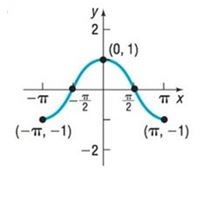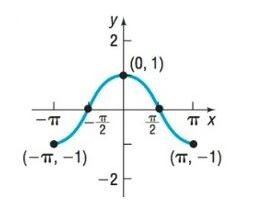
Concept explainers
In Problems 25-32, the graph of a function is given. Use the graph to find:
a. The intercepts, if any
b. The domain and range
c. The intervals on which the function is increasing, decreasing, or constant
d. Whether the function is even, odd, or neither
30.

To find: The following values using the given graph:
a. Intercepts ().
Answer to Problem 26AYU
From the graph, concluding the following results:
a.Intercepts ().
.
Explanation of Solution
Given:
It is asked to find the intercepts ( and if any), domain and range, increasing intervals, decreasing intervals, and constant intervals of the function using the graph. Also, check whether the function is even, odd or neither.
Graph:

Interpretation:
a. Intercepts (): The points, if any, at which a graph crosses or touches the coordinate axes are called the intercepts.
The of a point at which the graph crosses or touches the is an , and the of a point at which the graph crosses or touches the is an .
The intercepts of the graph are the points and .
The are and ; the is 1.
To find: The following values using the given graph:
b. The domain and range set of the function.
Answer to Problem 26AYU
From the graph, concluding the following results:
b. The domain and range set of the function.
The domain of is or the interval .
The range of is or the interval .
Explanation of Solution
Given:
It is asked to find the intercepts ( and if any), domain and range, increasing intervals, decreasing intervals, and constant intervals of the function using the graph. Also, check whether the function is even, odd or neither.
Graph:

Interpretation:
b. The domain and range set of the function.
To determine the domain of notice that the points on the graph of have between to , inclusive; and for each number between to , there is a point on the graph. The domain of is or the interval .
The points on the graph all have between and 1 inclusive; and for each such number , there is at least one number in the domain. The range of is or the interval .
To find: The following values using the given graph:
b. The domain and range set of the function.
Answer to Problem 26AYU
From the graph, concluding the following results:
b. The domain and range set of the function.
The domain of is or the interval .
The range of is or the interval .
Explanation of Solution
Given:
It is asked to find the intercepts ( and if any), domain and range, increasing intervals, decreasing intervals, and constant intervals of the function using the graph. Also, check whether the function is even, odd or neither.
Graph:

Interpretation:
b. The domain and range set of the function.
To determine the domain of notice that the points on the graph of have between to , inclusive; and for each number between to , there is a point on the graph. The domain of is or the interval .
The points on the graph all have between and 1 inclusive; and for each such number , there is at least one number in the domain. The range of is or the interval .
To find: The following values using the given graph:
d. Nature of the function (even, odd or neither).
Answer to Problem 26AYU
From the graph, concluding the following results:
d. The given function is an even function.
Explanation of Solution
Given:
It is asked to find the intercepts ( and if any), domain and range, increasing intervals, decreasing intervals, and constant intervals of the function using the graph. Also, check whether the function is even, odd or neither.
Graph:

Interpretation:
d. Nature of the function (even, odd or neither).
By the theorem of test for symmetry, “A function is even if and only if its graph is symmetric with respect to the . A function is odd if and only if its graph is symmetric with respect to the origin”.
It can be easily concluded from the graph and the above statement that the given function is symmetric with respect to .
Therefore, the given function is an even function.
Chapter 2 Solutions
Precalculus Enhanced with Graphing Utilities
Additional Math Textbook Solutions
A Problem Solving Approach To Mathematics For Elementary School Teachers (13th Edition)
Elementary Statistics (13th Edition)
Thinking Mathematically (6th Edition)
College Algebra with Modeling & Visualization (5th Edition)
Pre-Algebra Student Edition
- A 20 foot ladder rests on level ground; its head (top) is against a vertical wall. The bottom of the ladder begins by being 12 feet from the wall but begins moving away at the rate of 0.1 feet per second. At what rate is the top of the ladder slipping down the wall? You may use a calculator.arrow_forwardExplain the focus and reasons for establishment of 12.4.1(root test) and 12.4.2(ratio test)arrow_forwarduse Integration by Parts to derive 12.6.1arrow_forward
- Explain the relationship between 12.3.6, (case A of 12.3.6) and 12.3.7arrow_forwardExplain the key points and reasons for the establishment of 12.3.2(integral Test)arrow_forwardUse 12.4.2 to determine whether the infinite series on the right side of equation 12.6.5, 12.6.6 and 12.6.7 converges for every real number x.arrow_forward
- use Corollary 12.6.2 and 12.6.3 to derive 12.6.4,12.6.5, 12.6.6 and 12.6.7arrow_forwardExplain the focus and reasons for establishment of 12.5.1(lim(n->infinite) and sigma of k=0 to n)arrow_forwardExplain the focus and reasons for establishment of 12.5.3 about alternating series. and explain the reason why (sigma k=1 to infinite)(-1)k+1/k = 1/1 - 1/2 + 1/3 - 1/4 + .... converges.arrow_forward
 Calculus: Early TranscendentalsCalculusISBN:9781285741550Author:James StewartPublisher:Cengage Learning
Calculus: Early TranscendentalsCalculusISBN:9781285741550Author:James StewartPublisher:Cengage Learning Thomas' Calculus (14th Edition)CalculusISBN:9780134438986Author:Joel R. Hass, Christopher E. Heil, Maurice D. WeirPublisher:PEARSON
Thomas' Calculus (14th Edition)CalculusISBN:9780134438986Author:Joel R. Hass, Christopher E. Heil, Maurice D. WeirPublisher:PEARSON Calculus: Early Transcendentals (3rd Edition)CalculusISBN:9780134763644Author:William L. Briggs, Lyle Cochran, Bernard Gillett, Eric SchulzPublisher:PEARSON
Calculus: Early Transcendentals (3rd Edition)CalculusISBN:9780134763644Author:William L. Briggs, Lyle Cochran, Bernard Gillett, Eric SchulzPublisher:PEARSON Calculus: Early TranscendentalsCalculusISBN:9781319050740Author:Jon Rogawski, Colin Adams, Robert FranzosaPublisher:W. H. Freeman
Calculus: Early TranscendentalsCalculusISBN:9781319050740Author:Jon Rogawski, Colin Adams, Robert FranzosaPublisher:W. H. Freeman
 Calculus: Early Transcendental FunctionsCalculusISBN:9781337552516Author:Ron Larson, Bruce H. EdwardsPublisher:Cengage Learning
Calculus: Early Transcendental FunctionsCalculusISBN:9781337552516Author:Ron Larson, Bruce H. EdwardsPublisher:Cengage Learning





